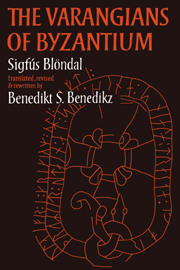Book contents
- Frontmatter
- Contents
- Illustrations
- Preface
- 1 Varangians and their origins
- 2 The army and navy of the High Byzantine Empire
- 3 Norse and Russian forces in the Byzantine army to the death of Romanos III
- 4 Haraldr Sigurðarson and his period as a Varangian in Constantinople, 1034–1043
- 5 The Varangians between 1042 and 1081
- 6 Varangians during the period 1081–1204
- 7 The ghost of the regiment: Varangian evidences 1204–1453
- 8 The Emperor, his Court, his guards and his city
- 9 Some individual Norse and English Varangians and travellers to Byzantium
- 10 Runic inscriptions concerning Varangians
- Select bibliography
- Index
8 - The Emperor, his Court, his guards and his city
Published online by Cambridge University Press: 19 October 2009
- Frontmatter
- Contents
- Illustrations
- Preface
- 1 Varangians and their origins
- 2 The army and navy of the High Byzantine Empire
- 3 Norse and Russian forces in the Byzantine army to the death of Romanos III
- 4 Haraldr Sigurðarson and his period as a Varangian in Constantinople, 1034–1043
- 5 The Varangians between 1042 and 1081
- 6 Varangians during the period 1081–1204
- 7 The ghost of the regiment: Varangian evidences 1204–1453
- 8 The Emperor, his Court, his guards and his city
- 9 Some individual Norse and English Varangians and travellers to Byzantium
- 10 Runic inscriptions concerning Varangians
- Select bibliography
- Index
Summary
In the eyes of his subjects the Emperor of the East was the visible symbol of Divine rule, and his Empire the visible image of the Heavenly Kingdom. This view is found among the Norse sources for Varangian history too, thus þórarinn loftunga refers to God in a poem as Grikklands gætir, ‘the Guardian of Greece’. There can be no doubt that the Westerners who came from far away, attracted by the report of the splendour of the Basileus and his enormous wealth, would be even more impressed when they saw the reality, especially in the golden age of the Macedonian dynasty. To them the stólkonungr, their corruption of the title they had picked up in Russia on their way (stolnyi knyaz), would indeed be the greatest of monarchs, and the wealth which he showered on them be amply sufficient to make them his loyal servants, alike in war and peace.
It is of course as warriors that these men came to settle in Byzantium, and the military aspect of the Empire was what concerned them most. During the greater part of the Varangian period, i.e. from the time of Constantine VII to the rape of the City in 1204, the Emperors were frequently generals of genius, such as Nicephorus Phocas, Basil II, Michael IV and the two first Comnenian Emperors, and even when less warlike sovereigns ruled there were commanders of distinction found in the Byzantine forces such as John Curcuas or George Maniaces, or the great Admiral Basil Boioannes.
- Type
- Chapter
- Information
- The Varangians of Byzantium , pp. 177 - 192Publisher: Cambridge University PressPrint publication year: 1979



